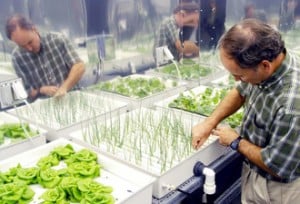The challenge of returning air to a state of healthy repair being a daunting one, what should be the goal: emissions reduction or emissions removal? If the sentiment is “reduction,” then the question is: reduction of what pollutants, and by what amount and over what length of time? There are many with varying ideas regarding this very thing.
And speaking of ideas, here’s one. It involves using greenhouses for carbon dioxide (CO2) capture. Huh?
Plants need CO2 to survive, right? So, with the so-called “additional” CO2 present in the atmosphere, what if some of this could be captured and put to use to help facilitate crop growth, particularly during times when less than optimal growing conditions are present?

Here is what I am getting at. I was reading the article “Hydroponics work with covered crops” in the April 2014 VGN or Vegetable Growers News issue, and in the article author A. J. Both of Rutgers University writes: “In the northeastern United States, the winter growing season is often accompanied by low sunlight conditions. As a result, in order to maintain sufficient crop production supplemental lighting is needed. Supplemental light intensities required for adequate crop production are relatively high, and as a result significant amounts of electric energy are needed.”1
First, a bit of clarification is in order here.
It is important to understand what is being discussed. The supplemental lighting the author’s alluded to, as I understand it, is as applied to covered crop production. What is meant by this I take it is crop growing that takes place within an enclosed structure of some sort such as in a greenhouse. Meanwhile, it is important to consider the clause: “significant amounts of electric energy.” The word “significant,” as used, is relative; a word open to interpretation. On the other hand, where “electric energy” is concerned, what is known absolutely is that with regard to the purchase of power, in paying for such money’s required and, as this has to do with growing crops in an enclosed environment, such may not be an inexpensive proposition.
And, in this regard, the author writes: “Therefore, proper management of the supplemental lighting system is needed for these production systems to be economical.”
But, there may be a better solution than proper supplemental lighting system management alone.
Regarding this, the author goes on to write: “During the winter, greenhouse carbon dioxide concentration can become depleted (because of limited ventilation rates needed for temperature control), and as a result enrichment with carbon dioxide might be needed. Under certain conditions, it is possible to ‘trade’ carbon dioxide enrichment for supplemental lighting and maintain acceptable growth rates. Carbon dioxide enrichment is usually less expensive compared to adding supplemental light.”
What Both did not, however, specifically address is what the source of the CO2 in question was.
So, what if the supply of CO2 for crop enrichment purposes could be obtained from fossil-fuels-based power generation processes?
Think about it for a moment. Supplemental lighting in an application such as with regard to enclosed structure crop growing and given the notion that electricity needed for such (during wintertime) is likely an expensive proposition as far as purchasing electricity goes, then by switching the supplemental lighting out and in its place bringing the proper amounts of CO2 in, not only would such a scenario result in the demand on the electricity supply being lower and the load on the power grid being less, presumably, but more of the CO2 that would otherwise be released into the atmosphere as waste could instead be put to use in helping to grow crops during winter specifically in enclosed environment applications.
There is no question the logistics would need to be worked out and determined as well beforehand would need to be the associated costs of setting up an arrangement of this nature to see if these costs pencil out, but my thinking here is this: one can’t ever know for sure until or unless something on this order is actually tried.
In my view, something on this order should not be outside the realm of possibility.
Notes
- A. J. Both, “Hydroponics work with covered crops,” Vegetable Growers News, Great American Publishing Inc., Apr. 2014, p. 27.
Image above: NASA, Kennedy Space Center
– Alan Kandel